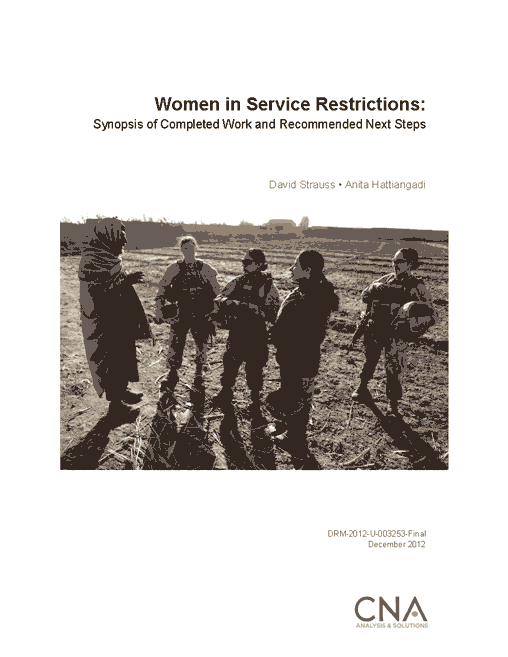Women in Service Restrictions
In January 1994, Secretary of Defense Les Aspin promulgated a memorandum issuing the Department of Defense (DOD) rules for assignment of women in the services [1]. Most notably, the rules prohibited women from serving in “units below the brigade level whose primary mission is to engage in direct combat on the ground.”
In addition to this direct ground combat exclusion, the memorandum allowed additional restrictions on the assignment of women where
- the service secretary attests that the costs of appropriate berthing and privacy arrangements are prohibitive;
- units and positions are doctrinally required to physically collocate and remain with direct ground combat units that are closed to women;
- units are engaged in long-range reconnaissance operations and Special Operations Forces missions; or job-related physical requirements would necessarily exclude the vast majority of women servicemembers.
Earlier this year, DOD eliminated the collocation restriction It also has allowed some female officers and staff noncommissioned officers to be assigned to some closed ground combat element (GCE) units at the battalion level as part of an “Exception to Policy.” Otherwise, the department continues to follow the policies established by the Aspin memo.
In accordance with the DOD policies, the Marine Corps restricts women from classification into combat arms primary military occupational specialties (PMOSs); that is, those in the 03 (infantry), 08 (artillery), and 18 (tank and assault amphibious vehicle) occupational fields (occfields). The Marine Corps also restricts female Marines in “open PMOSs” from assignments below the division level in the GCE—except for the headquarters battery in artillery regiments (and those in the Exception to Policy).
The FY 2011 National Defense Authorization Act (NDAA) directed the secretary of defense and the service secretaries to “conduct a review of laws, policies, and regulations, including the collocation policy, that may restrict the service of female members of the Armed Forces...” Accordingly, in January 2011, the Marine Corps formed an operational planning team (OPT) to review its existing policies related to women in the Marine Corps. CNA has been providing analytical support to the OPT since April 2011. The Assistant Commandant of the Marine Corps (ACMC) also asked CNA to conduct an independent study, providing information to help inform a decision about:
- Whether to change existing policies
- The effects of prospective policy changes on recruiting, retention, manpower management, and training processes.
During this study, we conducted extensive literature reviews; interviewed subject matter experts from other countries’ militaries, other organizations, and the Marine Corps; and conducted data analysis of existing survey and Marine Corps training data relevant to prospective policy decisions. We also developed a force survey (the Women in Combat Units survey—fielded through Marine Corps systems) intended to solicit the thoughts and attitudes of active component and Selected Reserve Marines about current ground combat exclusion policies and prospective policy changes.
In this document, we present a synopsis of our findings. Specifically, we summarize our research on:
- The number of women who expressed interest in ground combat
- Physiological differences between men and women
- Marines’ opinions about prospective policy changes
- Possible effects on recruiting and retention
- Marines’ anticipated benefits and concerns about opening ground combat occupations and units to women
- Lessons learned from other militaries and physically demanding professions
- Unit cohesion and related social concerns
- Sexual assault and harassment.
Finally, we discuss remaining challenges that the Marine Corps could face if it were to lift all remaining gender-related service restrictions, and we suggest topics for future analysis. Additional details on most of the issues discussed in this report can be found in our previously published documents.
Download reportCleared for Public Release; Distribution Unlimited.
Specific authority: N00014-11-D-0323.
Details
- Pages: 54
- Document Number: DRM-2012-U-003253-Final
- Publication Date: 12/21/2012
